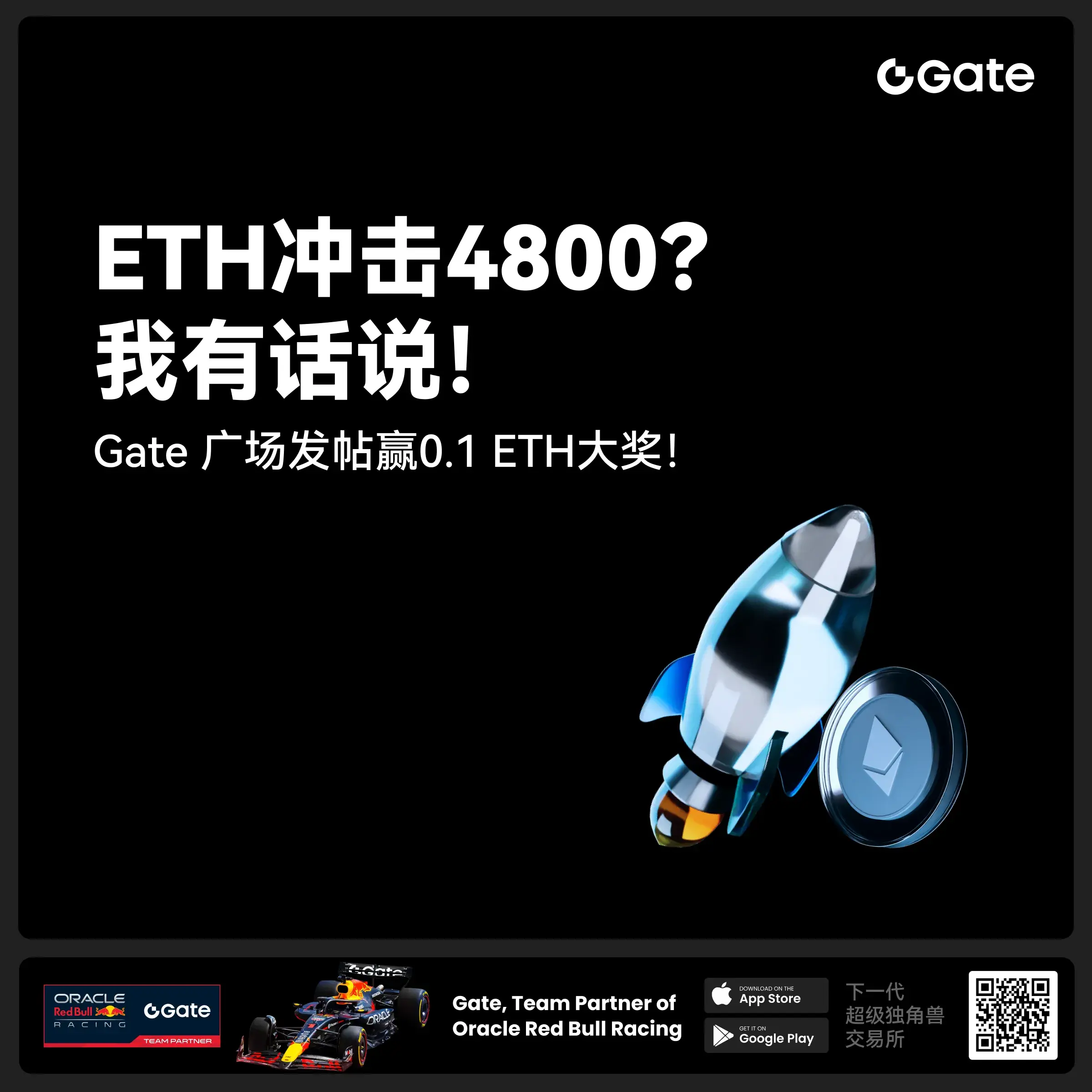- 話題1/3
25k 熱度
31k 熱度
26k 熱度
51k 熱度
19k 熱度
- 置頂
- 📢 Gate廣場 #MBG任务挑战# 發帖贏大獎活動火熱開啓!
想要瓜分1,000枚MBG?現在就來參與,展示你的洞察與實操,成爲MBG推廣達人!
💰️ 本期將評選出20位優質發帖用戶,每人可輕鬆獲得50枚MBG!
如何參與:
1️⃣ 調研MBG項目
對MBG的基本面、社區治理、發展目標、代幣經濟模型等方面進行研究,分享你對項目的深度研究。
2️⃣ 參與並分享真實體驗
參與MBG相關活動(包括CandyDrop、Launchpool或現貨交易),並曬出你的參與截圖、收益圖或實用教程。可以是收益展示、簡明易懂的新手攻略、小竅門,也可以是現貨行情點位分析,內容詳實優先。
3️⃣ 鼓勵帶新互動
如果你的帖子吸引到他人參與活動,或者有好友評論“已參與/已交易”,將大幅提升你的獲獎概率!
MBG熱門活動(帖文需附下列活動連結):
Gate第287期Launchpool:MBG — 質押ETH、MBG即可免費瓜分112,500 MBG,每小時領取獎勵!參與攻略見公告:https://www.gate.com/announcements/article/46230
Gate CandyDrop第55期:CandyDrop x MBG — 通過首次交易、交易MBG、邀請好友註冊交易即可分187,500 MBG!參與攻略見公告:https://www.gate.com/announcements
- 📢 #Gate广场征文活动第三期# 正式啓動!
🎮 本期聚焦:Yooldo Games (ESPORTS)
✍️ 分享獨特見解 + 參與互動推廣,若同步參與 Gate 第 286 期 Launchpool、CandyDrop 或 Alpha 活動,即可獲得任意獎勵資格!
💡 內容創作 + 空投參與 = 雙重加分,大獎候選人就是你!
💰總獎池:4,464 枚 $ESPORTS
🏆 一等獎(1名):964 枚
🥈 二等獎(5名):每人 400 枚
🥉 三等獎(10名):每人 150 枚
🚀 參與方式:
在 Gate廣場發布不少於 300 字的原創文章
添加標籤: #Gate广场征文活动第三期#
每篇文章需 ≥3 個互動(點讚 / 評論 / 轉發)
發布參與 Launchpool / CandyDrop / Alpha 任一活動的截圖,作爲獲獎資格憑證
同步轉發至 X(推特)可增加獲獎概率,標籤:#GateSquare 👉 https://www.gate.com/questionnaire/6907
🎯 雙倍獎勵機會:參與第 286 期 Launchpool!
質押 BTC 或 ESPORTS,瓜分 803,571 枚 $ESPORTS,每小時發放
時間:7 月 21 日 20:00 – 7 月 25 日 20:00(UTC+8)
🧠 寫作方向建議:
Yooldo
- 🎉Gate 2025 上半年社區盛典:內容達人評選投票火熱進行中 🎉
🏆 誰將成爲前十位 #Gate广场# 內容達人?
投票現已開啓,選出你的心頭好
🎁贏取 iPhone 16 Pro Max、限量週邊等好禮!
📅投票截止:8 月 15 日 10:00(UTC+8)
立即投票: https://www.gate.com/activities/community-vote
活動詳情: https://www.gate.com/announcements/article/45974
- 📢 #Gate广场征文活动第二期# 正式啓動!
分享你對 $ERA 項目的獨特觀點,推廣ERA上線活動, 700 $ERA 等你來贏!
💰 獎勵:
一等獎(1名): 100枚 $ERA
二等獎(5名): 每人 60 枚 $ERA
三等獎(10名): 每人 30 枚 $ERA
👉 參與方式:
1.在 Gate廣場發布你對 ERA 項目的獨到見解貼文
2.在貼文中添加標籤: #Gate广场征文活动第二期# ,貼文字數不低於300字
3.將你的文章或觀點同步到X,加上標籤:Gate Square 和 ERA
4.徵文內容涵蓋但不限於以下創作方向:
ERA 項目亮點:作爲區塊鏈基礎設施公司,ERA 擁有哪些核心優勢?
ERA 代幣經濟模型:如何保障代幣的長期價值及生態可持續發展?
參與並推廣 Gate x Caldera (ERA) 生態周活動。點擊查看活動詳情:https://www.gate.com/announcements/article/46169。
歡迎圍繞上述主題,或從其他獨特視角提出您的見解與建議。
⚠️ 活動要求:
原創內容,至少 300 字, 重復或抄襲內容將被淘汰。
不得使用 #Gate广场征文活动第二期# 和 #ERA# 以外的任何標籤。
每篇文章必須獲得 至少3個互動,否則無法獲得獎勵
鼓勵圖文並茂、深度分析,觀點獨到。
⏰ 活動時間:2025年7月20日 17
- 📢 ETH衝擊4800?我有話說!快來“Gate廣場”秀操作,0.1 ETH大獎等你拿!
牛市預言家,可能下一個就是你!想讓你的觀點成爲廣場熱搜、贏下ETH大獎?現在就是機會!
💰️ 廣場5位優質發帖用戶+X瀏覽量前5發帖用戶,瓜分0.1 ETH!
🎮 活動怎麼玩,0門檻瓜分ETH!
1.話題不服來辯!
帶 #ETH冲击4800# 和 #ETH# 在 廣場 或 K線ETH下 圍繞一下主題展開討論:
-ETH是否有望突破4800?
-你看好ETH的原因是什麼?
-你的ETH持倉策略是?
-ETH能否引領下一輪牛市?
2. X平台同步嗨
在X平台發帖討論,記得帶 #GateSquare# 和 #ETH冲击4800# 標籤!
把你X返連結提交以下表單以瓜分大獎:https://www.gate.com/questionnaire/6896
✨發帖要求:
-內容須原創,字數不少於100字,且帶活動指定標籤
-配圖、行情截圖、分析看法加分,圖文並茂更易精選
-禁止AI寫手和灌水刷屏,一旦發現取消獎勵資格
-觀點鮮明、邏輯清晰,越有料越好!
關注ETH風向,創造觀點價值,從廣場發帖開始!下一個牛市“預言家”,可能就是你!🦾🏆
⏰ 活動時間:2025年7月18日 16:00 - 2025年7月28日 23:59(UTC+8)
【立即發帖】 展現你的真知灼見,贏取屬於你的ETH大獎!
鏈下擴容方案深度解析:從狀態通道到Layer2
鏈下擴容深度解析
1. 擴容的必要性
區塊鏈的未來願景是去中心化、安全性和可擴展性,但通常只能實現其中兩個,這被稱爲區塊鏈的不可能三角問題。多年來,人們一直在探索如何解決這一難題,如何在保證去中心化和安全性的前提下,提高區塊鏈的吞吐量和交易速度,即解決擴容問題,是當前區塊鏈發展過程中的熱點話題之一。
區塊鏈的去中心化、安全性和可擴展性定義如下:
去中心化:任何人都可以成爲節點參與區塊鏈系統的生產和驗證,節點數量越多,則去中心化程度越高,從而確保網路不受一小羣大型中心化參與者的控制。
安全性:爲了獲取區塊鏈系統控制權所付出的成本越高,則安全性越高,那麼鏈就可以抵抗較大比例的參與者對其的攻擊。
可擴展性:區塊鏈處理大量交易的能力。
比特幣網路的第一次重大硬分叉就是源於擴容問題。隨着比特幣的用戶數量和交易量的增多,每個區塊上限爲1MB的比特幣網路開始面臨擁堵問題;2015年開始,比特幣社區就擴容問題存在分歧,一方是以Bitcoin BCH爲代表的支持擴大區塊的擴容派,另一方是以Bitcoin Core爲代表的小區塊派,認爲應當使用隔離見證Segwit方案去優化主鏈結構。2017年8月1日,Bitcoin BCH自行開發至8MB的客戶端系統開始運行,導致了比特幣歷史上第一次重大硬分叉的出現,同時也由此誕生了新幣種BCH。
同樣,以太坊網路也是選擇犧牲了一部分可擴展性,用來保障網路的安全性和去中心化;雖然以太坊網路並未像比特幣網路一樣通過限制區塊大小來限定交易量,而是變相轉變爲對單一區塊可容納的燃料費設置上限,但是目的都是爲了實現Trustless Consensus並確保節點的廣泛分布(無論取消還是提高限額都會淘汰很多帶寬、存儲和計算量不足的較小節點)。
從2017年的CryptoKitties,DeFi summer、再到後來GameFi和NFT等鏈上應用的興起,市場對吞吐量需求不斷增加,但即使是圖靈完備的以太坊每秒也只能處理15~45筆的交易(TPS),這導致的結果是交易成本不斷增加,結算時間變長,大部分Dapps難以承受運行成本,整個網路對於用戶而言也變的又慢又貴,區塊鏈擴容問題亟待被解決。理想狀態下的擴容方案是:在不犧牲去中心化和安全性的前提下,還能盡可能提高區塊鏈網路的交易速度(更短的finality time)和交易吞吐量(更高的TPS)。
2. 擴容方案的類別
我們按照"是否改變一層主網"作爲標準,把擴容方案分爲鏈上擴容和鏈下擴容兩大類。
2.1 鏈上擴容
核心概念:通過改變一層主網協議達到擴容效果的解決方案,目前的主要方案是分片。
鏈上擴容有多種方案,此篇文章不進行展開,以下簡要列舉兩種方案:
方案一是擴大區塊空間,即增加每個區塊打包的交易數量,但這會提高對高性能節點設備的要求,提高節點的加入門檻,降低了"去中心化"程度。
方案二是分片,將區塊鏈帳本分成若幹部分,不再是每個節點參與所有記帳,而是由不同分片即不同節點負責不同記帳,並行計算可以同時處理多個交易;這樣可降低節點計算壓力和加入門檻,提高交易處理速度和去中心化程度;但這意味着全網算力被分散,會降低整個網路的"安全性"。
改變一層主網協議的代碼可能會產生難以預料的負面影響,因爲底層任何細微的安全漏洞都會嚴重威脅整個網路的安全性,網路可能會被迫進行分叉或中斷修復升級。例如,2018年的Zcash的通脹漏洞事件:Zcash的代碼是基於比特幣0.11.2版本代碼修改的,2018年一位工程師發現其底層代碼存在高危漏洞,即代幣可無限增發,隨即團隊花了8個月的時間進行祕密修補,漏洞修復後才公開這一事件。
2.2 鏈下擴容
核心概念:不改變現有一層主網協議的擴容解決方案。
鏈下擴容方案又可以細分爲Layer2和其他方案:
Layer2:狀態通道、側鏈、Plasma、Rollups
其他:Validium、Volition
3. 鏈下擴容的方案
3.1 狀態通道(State Channels)
3.1.1 概要
狀態通道規定只有在通道打開、關閉或解決糾紛時,用戶才需要與主網進行交互,並把用戶與用戶的交互放在鏈下進行,以此來降低用戶交易的時間和金錢成本,並且實現交易次數不受限制。
狀態通道是簡單的P2P協議,適合"基於回合的應用程序",例如,兩人國際象棋遊戲。每個通道都由主網上運行的多籤智能合約管理,該合約控制存入通道的資產,驗證狀態更新,並仲裁參與者之間的爭議(根據帶有籤名和時間戳的欺詐證明)。參與者在區塊鏈網路部署合約後,存入一筆資金並鎖定,雙方籤名確認後,通道正式開通。通道允許參與者之間進行不限次數的鏈下免費交易(只要他們的轉帳淨值不超過存入的代幣總額)。參與者輪流發送狀態更新給對方,等待對方的籤名確認。一旦對方籤名確認,這筆狀態更新就算完成。正常情況下,雙方同意的狀態更新不會上傳主網,只有在出現爭議或關閉通道時,才會依賴主網確認。需要關閉通道時,任一參與者可在主網提出交易請求,如果退出請求獲得全員一致籤名批準,則鏈上立即執行,即智能合約根據通道最終狀態下每個參與者的餘額,分發剩餘的鎖定資金;如果其他參與者沒有籤名批準,則所有人需等待"挑戰期"的結束才能收到剩餘資金。
綜上,狀態通道方案可以大大減少主網計算量,提升交易速度,降低交易成本。
3.1.2 時間線
2015年2月,Joseph Poon和Thaddeus Dryja發布了閃電網絡白皮書草案。
2015年11月,Jeff Coleman首次系統性總結了State Channel的概念,提出比特幣的Payment Channel是State Channel概念中的一個子案例。
2016年1月,Joseph Poon和Thaddeus Dryja正式發表白皮書《The Bitcoin Lightning Network: Scalable Off-Chain Instant Payments》提出比特幣閃電網絡的擴容方案Payment Channel(支付通道),該方案僅用於處理比特幣網路上的轉帳支付。
2017年11月,第一個基於Payment Channel框架下的有關State Channel的設計規範Sprites被提出。
2018年6月,Counterfactual提出了一個非常詳細的Generalized State Channels設計,這是第一個完全與狀態通道相關的設計。
2018年10月,文章Generalised State Channel Networks提出State Channel Networks和Virtual Channels的概念。
2019年2月,狀態通道的概念擴展到N-Party Channels,Nitro是首個基於該想法建立的協議。
2019年10月,Pisa爲了解決所有參與者需要持續在線的問題,拓展了Watchtowers的概念。
2020年3月,Hydra提出Fast Isomorphic Channels。
3.1.3 技術原理
狀態通道的工作流程如下:
Alice和Bob通過從其個人EOA存入資金到鏈上合約地址,這些資金被鎖定在合約中,直到通道關閉時才將餘額返回給用戶;二人籤名確認後,二人之間的狀態通道正式開通。
Alice和Bob通過該通道理論上可在鏈下開展不限次數的交易,參與者通過加密的籤名消息相互通信(而不是與區塊鏈網路通信)。雙方用戶都需要對每筆交易進行籤名,以防止雙花作惡。通過這些消息,他們提出自己帳戶的狀態更新,並接受對方提出的狀態更新。
如果Alice想關閉通道結束和Bob之間的交易,Alice需要向合約提交自己帳戶的最終狀態,如果Bob籤名批準,合約則會根據最終狀態將鎖定的資金釋放返回對應用戶。如果Bob未響應籤名,合約則會在挑戰期結束後將鎖定的資金釋放返回對應用戶。
如果在某個時間點,Bob在他的輪次中不響應Alice發送來的狀態更新籤名,此時,Alice可以通過向合約提交自己最後一次的有效狀態來發起挑戰,這個有效狀態也包含了Bob之前的籤名,從而證明最後一筆交易已經收到Bob的批準,最後狀態已經收到Bob的確認。然後,合約允許Bob在一段時間內通過將下一個狀態提交給合約進行響應;如果Bob響應,則二人可以繼續在狀態通道內進行交易;如果Bob在該時間段內沒有響應,則合約自動關閉狀態通道並將資金返回給Alice。
3.1.4 優缺點
優點:
缺點:
3.1.5 應用
比特幣閃電網絡
概述:閃電網絡是比特幣網路的小額支付通道,其整體技術演變經歷:2/2多籤構建單向支付通道,增加RSMC(Revocable Sequence Maturity Contract)後可構建雙向支付通道,再增加HTLC(Hash Time Lock Contract)後可連接支付通道拓展到多人支付,最終構建支付網絡即閃電網絡。通過鏈下小額支付通道,然後借助中間人構成交易網路,可以解決比特幣網路擴容問題。閃電網絡的整體使用遵循着"存款(建立通道)→閃電網絡交易(更新通道狀態)→退款/結算(結束通道)"的流程;理論上閃電網絡每秒可以處理一百萬筆交易。
時間線: